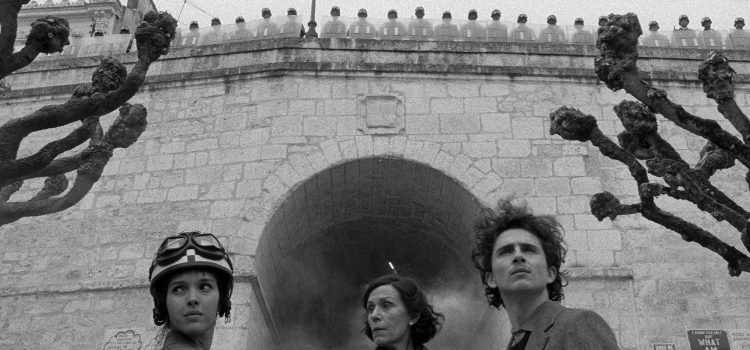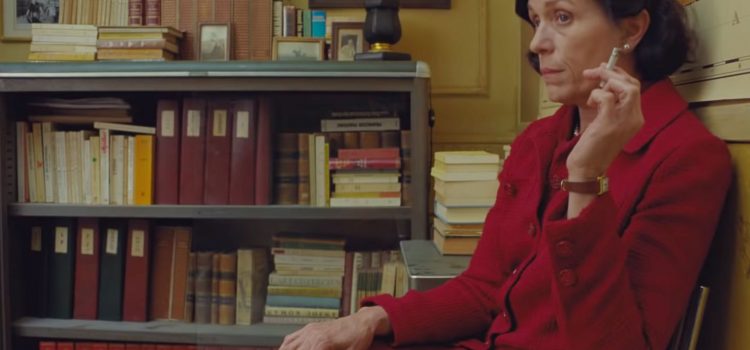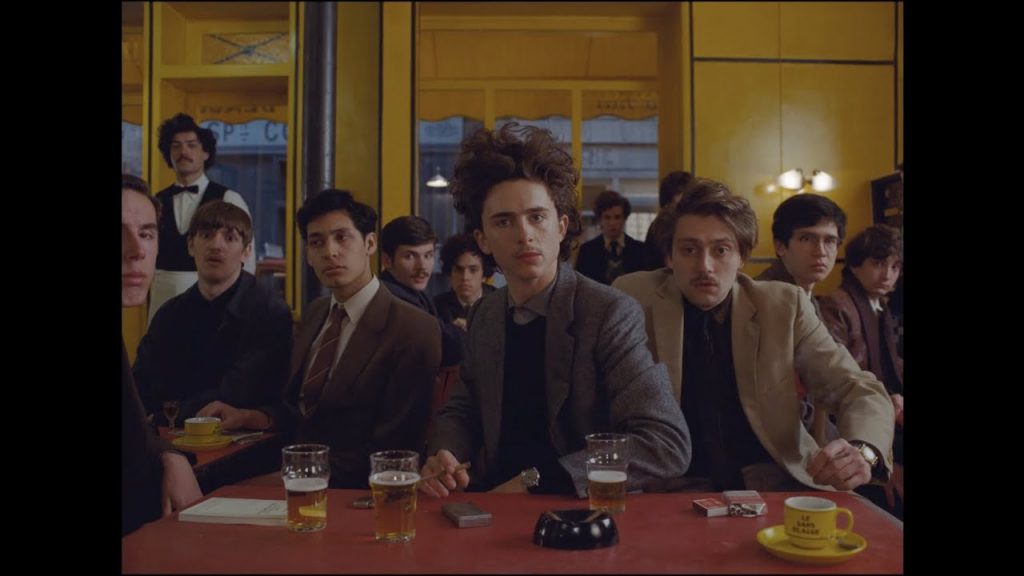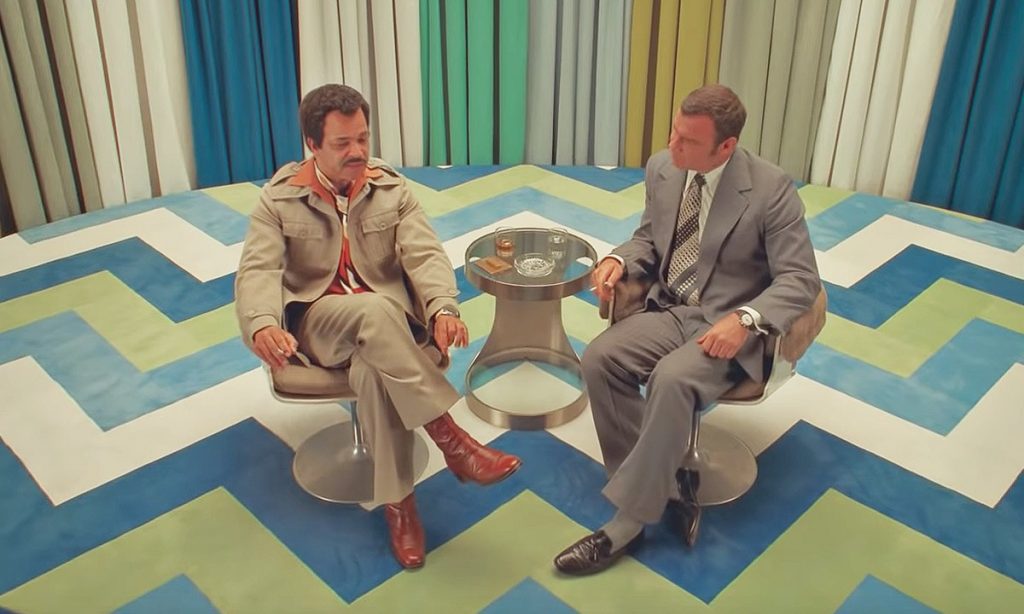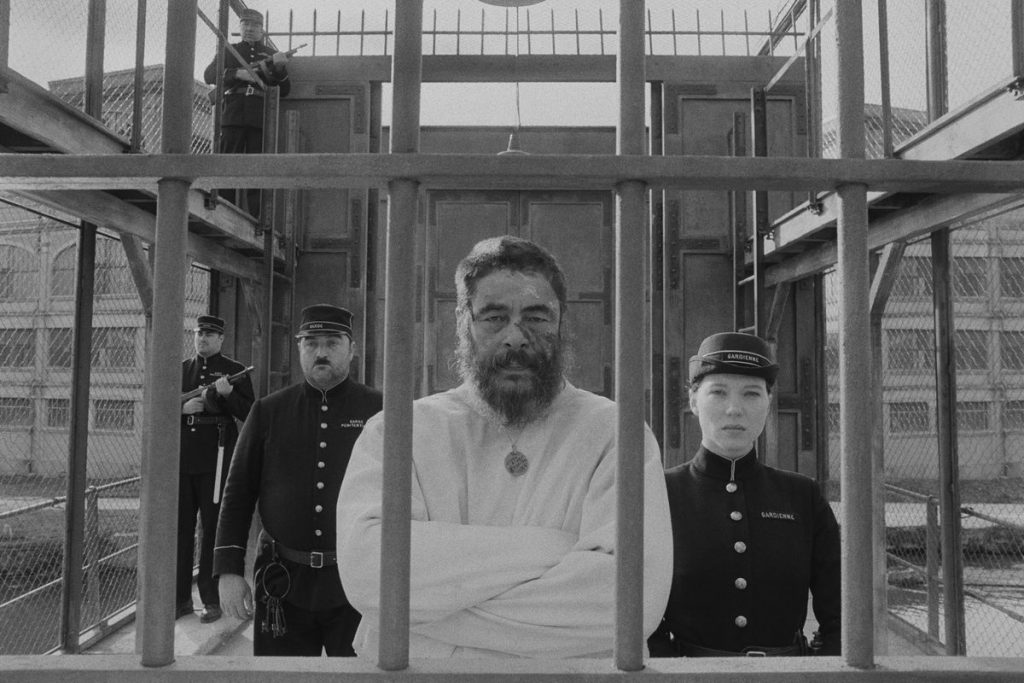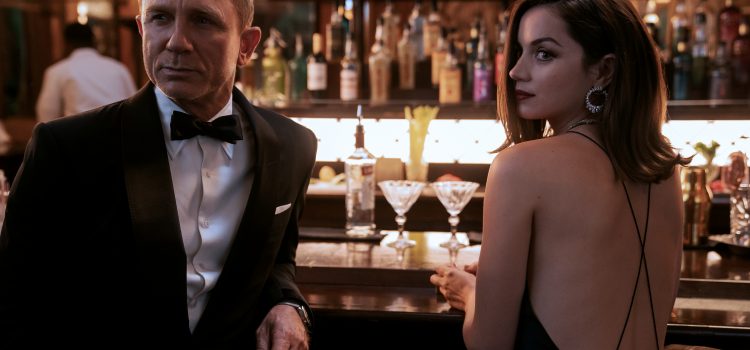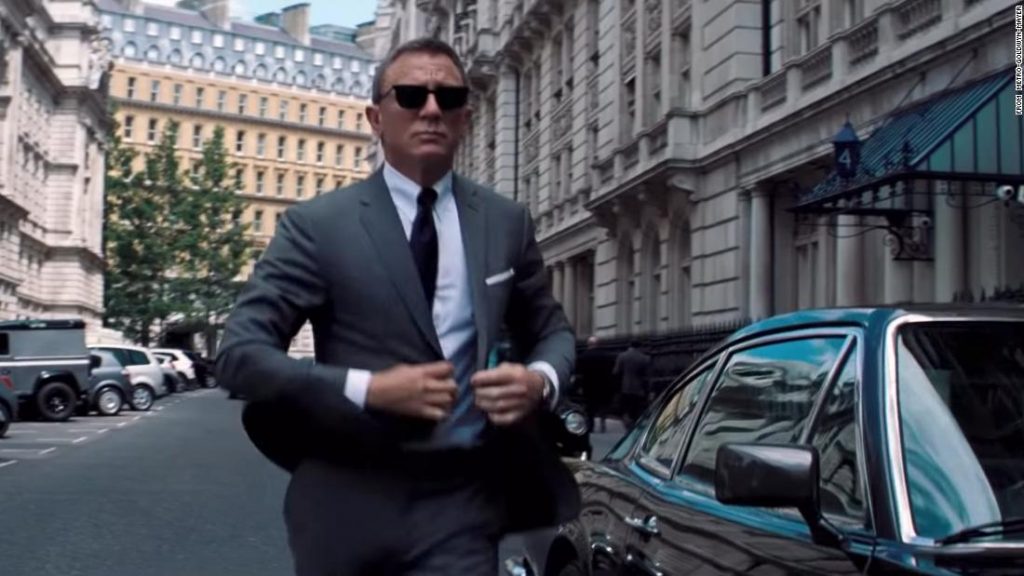By Lynn Venhaus
Think New Yorker meets Highlights for the literary geek chic. As a paean to print, “The French Dispatch” is a glorious reminder of how turning pages, enraptured in an article, can take us away to other worlds.
Set in an outpost of an American newspaper – the Liberty, Kansas Evening Sun — in a fictional 20th century French city. It brings to life a collection of stories published in the final edition of the newspaper empire’s Sunday magazine, following the death of the editor (Bill Murray).
Experiencing a Wes Anderson film is like being transported into an illustrated picture book with stunning artistically complex worlds both familiar and of wonder – feeling new and nostalgic at the same time.
It is always a unique event that I look forward to with great anticipation, having listed “The Royal Tenenbaums,” “Moonrise Kingdom” and “The Grand Budapest Hotel” among my favorite movies of the 21st Century. And his whimsical stop-animation features “The Fantastic Mr. Fox” and “The Isle of Dogs” (his last movie in 2018) are genius.
No matter if they connect or not, all his films of the past 30 years are painstakingly detailed works of art that offer something different – and feature wit, eccentric characters, superb music accompaniment, and striking composed visuals as common threads.
Therefore, it pains me to say that while “The French Dispatch” is a love letter to journalists and has considerable quirky charms, with dizzying fanciful techniques and the director’s distinctive symmetrical style, color palette and designs, it is at once too much and not enough.
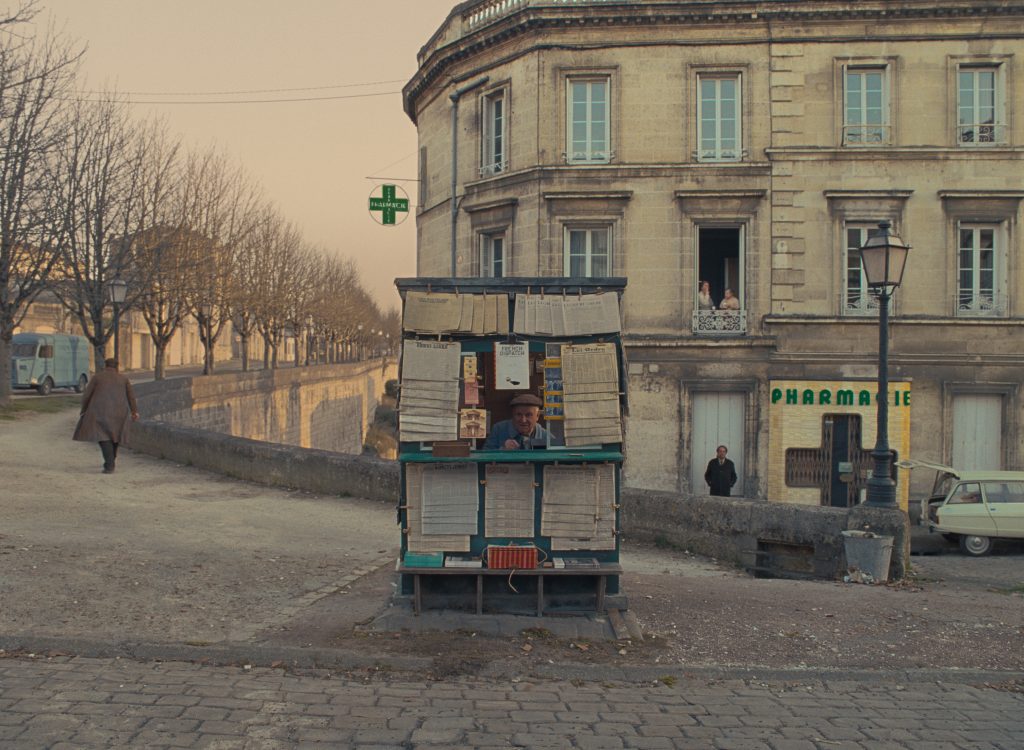
Set in the truly inspired metropolis Ennui-sur-Blasé (which translated, means “Boredom-on-Apathy,” with a wink), this sophisticated exercise is an overstuffed toy box that melds too many concepts to be as satisfying as his top three. And despite its splendid cast, there isn’t a single character that emotionally resonates.
This anthology, running 1 hour 48 minutes, is crowded with enough content for 10 movies. Anderson’s offbeat screenplay, with a story conceived with Roman Coppola, Jason Schwartzman, and Hugo Guinness, is divided to fit the magazine’s sections: arts and artists, politics/poetry and tastes and smells, but starts and ends with the life and death of diligent editor Arthur Horowitz Jr. – played by Anderson all-star Bill Murray, just as droll as ever.
In “The Concrete Masterpiece” by J.K.L. Berensen (Tilda Swinton), which goes off the rails two-thirds in, Benicio del Toro plays Moses Rosenthaler, a psychopathic artist who paints critically acclaimed abstracts in prison, uses Simone (Lea Seydoux), a female prison guard as a nude model, and attracts the attention of Cadazio, an imperious, impatient art exhibitor played by Adrien Brody, backed by his two businessmen uncles (brief appearance by Henry Winkler and Bob Balaban).
“Revisions to a Manifesto” has student radicals protest, which leads to “The Chessboard Revolution,” with rebel leader Zeffirelli (Timothee Chalamet), who gets the attention of no-nonsense scribe Lucinda Krementz (Frances McDormand). This meanders and should have ended midway.
The third is “The Private Dining Room of the Police Commissioner,” as recounted by urbane food writer Roebuck Wright (Jeffrey Wright) in a television interview with talk show host (Liev Schreiber). This is a complex crime caper involving multiple characters, many locations, and quite a roster of talent.
At times, these short stories seem indulgent, rambling, and tedious. Sharper pacing would have helped with the storytelling, which does benefit from the gifted performers who find their rhythm and deliver crisp dialogue in the earnest manner one expects in these idiosyncratic tableaus.
Owen Wilson, who has been in eight Anderson movies, second only to Murray, is good-natured staff writer Herbsaint Sazerac, who takes us on an amusing tour of the city. Anjelica Huston, aka Mrs. Tenenbaum, capably handles narration duty this time –a lovely addition.
One of the pleasures of this film is to see such a star-studded array of repertory players, and more – among them, Saoirse Ronan, Tony Revolori, Christoph Waltz, Willem Dafoe, Edward Norton, Steve Park, Lois Wilson, Fisher Stevens, and Griffin Dunne.
The pandemic delayed this film’s release by a year, which heightened expectations and allowed a clever literary marketing campaign to enchant with graphics and snippets, modeled after venerable periodicals from days gone by. The film premiered at the Cannes Film Festival in July, where it received a nine-minute standing ovation.
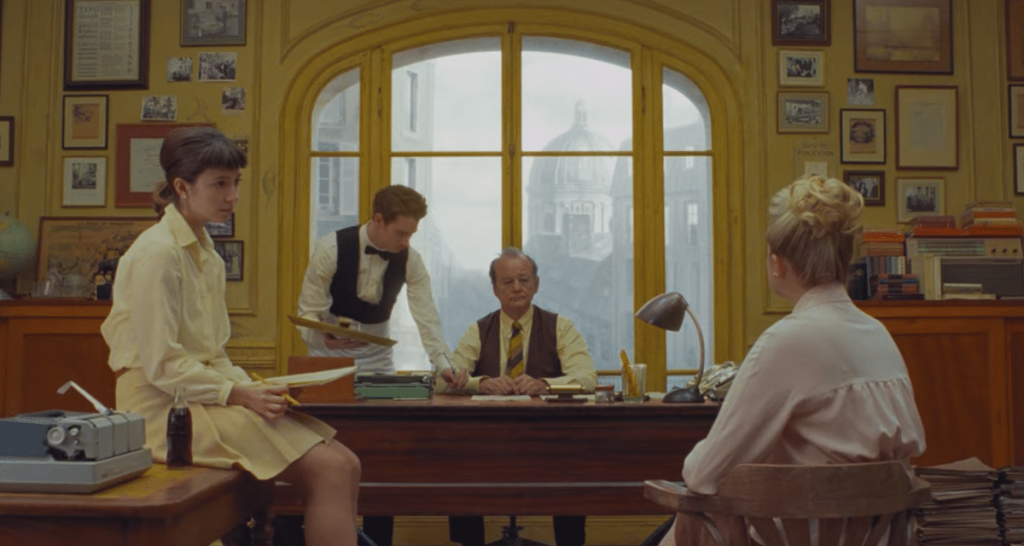
Having spent nearly a half-century working at publications, the editorial office setting was the most intriguing yet the least focus — an aperitif instead of an entrée. With every bon mot that Murray tossed off as the veteran editor corralled correspondents, I wanted more of that colorful staff.
The sight of Murray taking a pencil to hard copy, as ink-stained editors once did in non-cubical newsrooms, should make journalists yearn for a grizzled authority figure to cut their long-winded prose and hand the typed papers back with gruff remarks and certain expectations. Writers may weep at the sight of a proofreader and a layout guy trying to fit linotype into a grid, for it’s part of a cherished past.
As a film, tightening those long-winded vignettes would have made a difference.
Nevertheless, the production elements are exceptional, especially from frequent Anderson cinematographer Robert D. Yeoman, flipping between black-and-white and color, and other collaborators Oscar-winning production designer Adam Stockhausen (for “Grand Budapest Hotel”) and costume designer Milena Canonero, four-time Oscar winner including “Grand Budapest Hotel,” and composer Alexander Desplat’s score.
Still, a Wes Anderson movie is like hanging out with erudite English Literature majors, some of whom are raconteurs and iconoclasts, who motivate you to add books and adventures to your to-do lists.
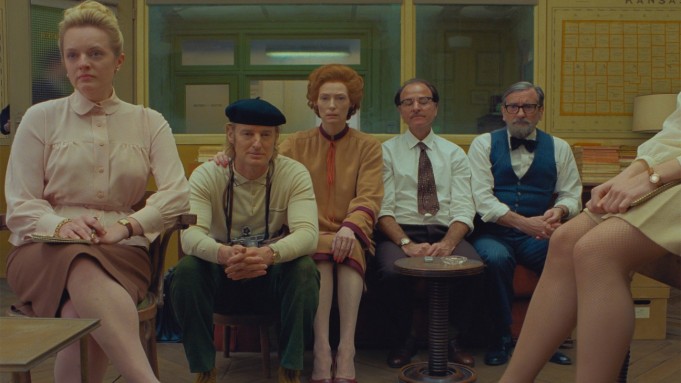
“The French Dispatch” is a 2021 comedy-drama directed by Wes Anderson and starring Bill Murray, Benicio del Toro, Lea Seydoux, Timothee Chalamet, Frances McDormand, Tilda Swinton, Adrien Brody, Jeffrey Wright, Owen Wilson and Elisabeth Moss. It’s run time is 1 hour, 48 minutes and is rated R for graphic nudity, some sexual references and language. In theaters Oct. 29. Lynn’s Grade: B.
Portions of this review were published in the Webster-Kirkwood Times and discussed on KTRS Radio.

Lynn (Zipfel) Venhaus has had a continuous byline in St. Louis metro region publications since 1978. She writes features and news for Belleville News-Democrat and contributes to St. Louis magazine and other publications.
She is a Rotten Tomatoes-approved film critic, currently reviews films for Webster-Kirkwood Times and KTRS Radio, covers entertainment for PopLifeSTL.com and co-hosts podcast PopLifeSTL.com…Presents.
She is a member of Critics Choice Association, where she serves on the women’s and marketing committees; Alliance of Women Film Journalists; and on the board of the St. Louis Film Critics Association. She is a founding and board member of the St. Louis Theater Circle.
She is retired from teaching journalism/media as an adjunct college instructor.

